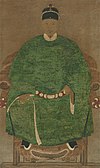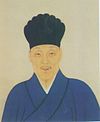House of Koxinga
This article may require copy editing for grammar, style, cohesion, tone, or spelling. (December 2023) |
| House of Koxinga 鄭氏 / Zheng | |
|---|---|
| Royal family in East Asia | |
 Flag of the Kingdom of Tungning | |
| Country | Chongzhen of Ming (1628) Longwu of Southern Ming (1645) Yongli of Southern Ming (1646) Kingdom of Tungning (1662) |
| Founded | 1655 Founder's elevation to Prince of Yanping |
| Founder | Koxinga |
| Final ruler | Zheng Keshuang |
| Titles | Prince of Yanping (延平王) King of Tungning (東寧國王)[1] King of Daepeon (大樊國主)[2] King of Taiwan[3] Sia (舍)[4] |
| Dissolution | 1683 |
| Deposition | Defeated by the Qing Dynasty in the Battle of Penghu |
| Cadet branches | Tagawa-shi |
The House of Koxinga or the Zheng dynasty was the reigning family of the Kingdom of Tungning in Taiwan. They played a significant role in the history of East Asia and Southeast Asia, particularly in the seventeenth century.[5]
Names[edit]
In Chinese, the dynasty is referred to as:
- The Zheng clan (Chinese: 鄭氏; Pe̍h-ōe-jī: Tēⁿ-sī).
- The House of Zheng in Taiwan (Chinese: 台灣鄭氏; Pe̍h-ōe-jī: Tâi-oân Tēⁿ-sī)
- The Family of Koxinga (Chinese: 鄭成功家族; Pe̍h-ōe-jī: Tēⁿ Sêng-kong Ka-cho̍k)
Overview[edit]
This section needs expansion. You can help by adding to it. (May 2020) |

Following the Qing conquest of the Kingdom of Tungning in 1683, the territory's last ruler, Zheng Keshuang, Prince of Yanping, who was a grandson of Koxinga, was taken to Beijing.[5] The Kangxi Emperor granted Zheng a peerage title, that of Duke Hanjun, and inducted him and his descendants into the Plain Red Banner.[5] The family remained in Beijing until 1911 when the Xinhai revolution broke out and the Qing dynasty's fell, after which they moved back to Anhai and Nan'an in southern Fujian, where they remain to this day.[5]
Koxinga's other descendants had the hereditary title of 'Sia'.[4] They are found both on mainland China and in Taiwan, while descendants of Koxinga's brother Shichizaemon live in Japan.
His descendants through one of his sons Zheng Kuan live in Taiwan.[6] One of Koxinga's descendants on mainland China, Zheng Xiaoxuan 鄭曉嵐 the father of Zheng Chouyu 鄭愁予, fought against the Japanese in the Second Sino-Japanese War. Zheng Chouyu was born in Shandong in mainland China and called himself a "child of the resistance" against Japan and he became a refugee during the war, moving from place to place across China to avoid the Japanese. He moved to Taiwan in 1949 and focuses his work on building stronger ties between Taiwan and mainland China.[7] Zheng Chouyu was born in mainland China, he identified as Chinese and he felt alienated after he was forced to move to Taiwan in 1949 which was previously under Japanese rule and felt strange and foreign to him.[8]
Rulers of the Kingdom of Tungning[edit]
The House of Koxinga produced five rulers of the Kingdom of Tungning, three as reigning monarchs and two as regents.
| No. | Portrait | Name (Birth–Death) |
Title(s) | Reign (Lunar calendar) | |
|---|---|---|---|---|---|
| 1 | 
|
Zheng Chenggong (Koxinga) 鄭成功 Zhèng Chénggōng (1624–1662) |
Prince of Yanping (延平王) Prince Wu of Chao (潮武王) |
14 June 1661 Yongli 15-5-18 |
23 June 1662 Yongli 16-5-8 |
| 2 | 
|
Zheng Xi 鄭襲 Zhèng Xí (1625–?) |
Protector (護理) | 23 June 1662 Yongli 16-5-8 |
30 November 1662 Yongli 17 |
| 3 | 
|
Zheng Jing 鄭經 Zhèng Jīng (1642–1681) |
Prince of Yanping (延平王) Prince Wen of Chao (潮文王) |
30 November 1662 Yongli 17 |
17 March 1681 Yongli 35-1-28 |
| 4 | 
|
Zheng Kezang 鄭克𡒉 Zhèng Kèzāng (1662–1681) |
Prince Regent (監國) | 17 March 1681 Yongli 35-1-28 |
19 March 1681 Yongli 35 |
| 5 | 
|
Zheng Keshuang 鄭克塽 Zhèng Kèshuǎng (1670–1707) |
Prince of Yanping (延平王) Duke Hanjun (漢軍公) |
19 March 1681 Yongli 35 |
5 September 1683 Yongli 37-8-13 |
Genealogy[edit]
| Adoption | |||||||||||||||||||||||||||||||||||||||||||||||||||||||||||||||||||||||||||||||||||||||||||||||||||||||||||||||||||||||||||||||||||||||||||||||||||||||||||||||||||||||||||||||||||||||||||||||||||||||||||||||||||||||||||||||||||||||||||||||||||||||||||||||||||||||||||||||||||||||||||||||||||||||||||||||||||||||||||||||||||||||||||||||||||||||||||||||
| Zheng Zhilong | |||||||||||||||||||||||||||||||||||||||||||||||||||||||||||||||||||||||||||||||||||||||||||||||||||||||||||||||||||||||||||||||||||||||||||||||||||||||||||||||||||||||||||||||||||||||||||||||||||||||||||||||||||||||||||||||||||||||||||||||||||||||||||||||||||||||||||||||||||||||||||||||||||||||||||||||||||||||||||||||||||||||||||||||||||||||||||||||
| Prince of Yanping | |||||||||||||||||||||||||||||||||||||||||||||||||||||||||||||||||||||||||||||||||||||||||||||||||||||||||||||||||||||||||||||||||||||||||||||||||||||||||||||||||||||||||||||||||||||||||||||||||||||||||||||||||||||||||||||||||||||||||||||||||||||||||||||||||||||||||||||||||||||||||||||||||||||||||||||||||||||||||||||||||||||||||||||||||||||||||||||||
| Zheng Chenggong (KOXINGA) | Tagawa Shichizaemon | Zheng Du | Zheng En | Zheng Yin | Zheng Xi | Zheng Mo | |||||||||||||||||||||||||||||||||||||||||||||||||||||||||||||||||||||||||||||||||||||||||||||||||||||||||||||||||||||||||||||||||||||||||||||||||||||||||||||||||||||||||||||||||||||||||||||||||||||||||||||||||||||||||||||||||||||||||||||||||||||||||||||||||||||||||||||||||||||||||||||||||||||||||||||||||||||||||||||||||||||||||||||||||||||||||
| Zheng Jing | Zheng Cong | Zheng Ming | Zheng Rui | Zheng Zhi | Zheng Kuan | Zheng Yu | Zheng Wen | Zheng Rou | Zheng Fa | Zheng Gang | Zheng Shou | Zheng Wei | Zheng Fu | Zheng Yan | Zheng Zuanwu | Zheng Zuanwei | |||||||||||||||||||||||||||||||||||||||||||||||||||||||||||||||||||||||||||||||||||||||||||||||||||||||||||||||||||||||||||||||||||||||||||||||||||||||||||||||||||||||||||||||||||||||||||||||||||||||||||||||||||||||||||||||||||||||||||||||||||||||||||||||||||||||||||||||||||||||||||||||||||||||||||||||||||||||||||||||||||||||||||||||
| Niru | |||||||||||||||||||||||||||||||||||||||||||||||||||||||||||||||||||||||||||||||||||||||||||||||||||||||||||||||||||||||||||||||||||||||||||||||||||||||||||||||||||||||||||||||||||||||||||||||||||||||||||||||||||||||||||||||||||||||||||||||||||||||||||||||||||||||||||||||||||||||||||||||||||||||||||||||||||||||||||||||||||||||||||||||||||||||||||||||
| Zheng Kezang | Zheng Keshuang | Zheng Kexue | Zheng Kejun | Zheng Keba | Zheng Kemu | Zheng Keqi | Zheng Keqiao | Zheng Ketan | Zheng Kezhang | Zheng Kepei | Zheng Kechong | Zheng Kezhuang | Zheng Bingmo | Zheng Kegui | Zheng Bingcheng | Zheng Bingxun | Zheng Kexi | Zheng Wen | Zheng Bao | Zheng Yu | Zheng Kun | Zheng Ji | Zheng Zhong | ||||||||||||||||||||||||||||||||||||||||||||||||||||||||||||||||||||||||||||||||||||||||||||||||||||||||||||||||||||||||||||||||||||||||||||||||||||||||||||||||||||||||||||||||||||||||||||||||||||||||||||||||||||||||||||||||||||||||||||||||||||||||||||||||||||||||||||||||||||||||||||||||||||||||||||||||||||||||||||||||||||||||
| Zheng Anfu | Zheng Anlu | Zheng Ankang | Zheng Anji | Zheng Andian | Zheng Ande | Zheng Yan | Zheng Yi | Zheng Qi | Zheng Anxi | Zheng Anqing | Zheng Anxiang | Zheng Anguo | Zheng Anrong | Zheng Anhua | Xialing | Bailing | Shunling | Yongling | Changling | Qingling | |||||||||||||||||||||||||||||||||||||||||||||||||||||||||||||||||||||||||||||||||||||||||||||||||||||||||||||||||||||||||||||||||||||||||||||||||||||||||||||||||||||||||||||||||||||||||||||||||||||||||||||||||||||||||||||||||||||||||||||||||||||||||||||||||||||||||||||||||||||||||||||||||||||||||||||||||||||||||||||||||||||||||||
| Zheng Shijun | Zheng Xianji | Zheng Xiansheng | Zheng Fu | Zheng Beng | Zheng Ai | Zheng Xian | Zheng Pin | Zheng Weng | Zheng Ming | Zheng Rui | Zheng Xing | Zheng Sheng | Zheng Jia | Zheng Guan | Zheng Pin | Zheng Qi | Zheng Tu | Zheng Dian | Zheng Lin | Zheng Qi | |||||||||||||||||||||||||||||||||||||||||||||||||||||||||||||||||||||||||||||||||||||||||||||||||||||||||||||||||||||||||||||||||||||||||||||||||||||||||||||||||||||||||||||||||||||||||||||||||||||||||||||||||||||||||||||||||||||||||||||||||||||||||||||||||||||||||||||||||||||||||||||||||||||||||||||||||||||||||||||||||||||||||||
| Zheng Bin | Zheng Min | Zheng Chang | Zheng Jin | Zheng Gui | Zheng Song | Zheng Bo | Zheng Ji | Zheng Bangxun | Zheng Bangrui | Zheng Bangning | Zheng Wenkui | Zheng Wenbi | Zheng Wen'ying | Zheng Wenfang | Zheng Wenguang | Zheng Wenzhong | Zheng Wenquan | Zheng Wen'wu | Zheng Wenlian | Zheng Wenmin | Zheng Wenhan | ||||||||||||||||||||||||||||||||||||||||||||||||||||||||||||||||||||||||||||||||||||||||||||||||||||||||||||||||||||||||||||||||||||||||||||||||||||||||||||||||||||||||||||||||||||||||||||||||||||||||||||||||||||||||||||||||||||||||||||||||||||||||||||||||||||||||||||||||||||||||||||||||||||||||||||||||||||||||||||||||||||||||||
| Zheng Jizong | Zheng Chengzong | Zheng Cheng'en | Zheng Cheng'yao | Zheng Chenggang | Zheng Chengxu | Liubu | Qinglu | Qingfu | Qing'yu | Qingxiang | Shuangding | Qingpu | Qingmao | Yingpu | Shanpu | Qingxi | |||||||||||||||||||||||||||||||||||||||||||||||||||||||||||||||||||||||||||||||||||||||||||||||||||||||||||||||||||||||||||||||||||||||||||||||||||||||||||||||||||||||||||||||||||||||||||||||||||||||||||||||||||||||||||||||||||||||||||||||||||||||||||||||||||||||||||||||||||||||||||||||||||||||||||||||||||||||||||||||||||||||||||||||
| Ruishan | Tushan | Deshan | Rongshan | Deyin | Deyu | Songhai | Deshou | Chang'en | Shi'en | Fu'en | Songtai | ||||||||||||||||||||||||||||||||||||||||||||||||||||||||||||||||||||||||||||||||||||||||||||||||||||||||||||||||||||||||||||||||||||||||||||||||||||||||||||||||||||||||||||||||||||||||||||||||||||||||||||||||||||||||||||||||||||||||||||||||||||||||||||||||||||||||||||||||||||||||||||||||||||||||||||||||||||||||||||||||||||||||||||||||||||
| Yufang | Yuhai | Yuchen | Enrong | Enfu | Enlu | Enhou | Enbao | Enlian | Xingsheng | Yulin | Yucheng | Yushan | Yufu | Yuhai | Yusheng | Yuliang | Runquan | ||||||||||||||||||||||||||||||||||||||||||||||||||||||||||||||||||||||||||||||||||||||||||||||||||||||||||||||||||||||||||||||||||||||||||||||||||||||||||||||||||||||||||||||||||||||||||||||||||||||||||||||||||||||||||||||||||||||||||||||||||||||||||||||||||||||||||||||||||||||||||||||||||||||||||||||||||||||||||||||||||||||||||||||
| Zheng Yi | Zheng Ze | Chongxu | Erkang | ||||||||||||||||||||||||||||||||||||||||||||||||||||||||||||||||||||||||||||||||||||||||||||||||||||||||||||||||||||||||||||||||||||||||||||||||||||||||||||||||||||||||||||||||||||||||||||||||||||||||||||||||||||||||||||||||||||||||||||||||||||||||||||||||||||||||||||||||||||||||||||||||||||||||||||||||||||||||||||||||||||||||||||||||||||||||||||
| Zheng Jichang | Shuzeng | Shuyue | Shuwang | ||||||||||||||||||||||||||||||||||||||||||||||||||||||||||||||||||||||||||||||||||||||||||||||||||||||||||||||||||||||||||||||||||||||||||||||||||||||||||||||||||||||||||||||||||||||||||||||||||||||||||||||||||||||||||||||||||||||||||||||||||||||||||||||||||||||||||||||||||||||||||||||||||||||||||||||||||||||||||||||||||||||||||||||||||||||||||||
See also[edit]
References[edit]
- ^ 九州大学文学部附属九州文化史硏究施設会 (1956). 《九州文化史研究所所蔵古文書目錄》 第17卷 (in Japanese). 日本: 九州文化史研究所.
- ^ 《朝鮮顯宗大王實錄》:「本南蠻地,蠻人甲必丹主之。其後寢弱,故明之遺民,多入居之。大樊國遣游擊柯貴主之。大樊國乃鄭錦舍所主也。隆武時有鄭成功者,賜國姓,封鎮國大將軍。與清兵戰,清人累敗。未幾死,其子錦舍繼封仁德將軍,逃入大樊,有衆數十萬。其地在福建海外,方千餘里。」
- ^ 王泰升等 (2006-07-01). 《追尋臺灣法律的足跡: 事件百選與法律史研究》 (in Chinese). 台灣: 五南出版社. ISBN 9571141747.
- ^ a b Academia Sinica. "siá". Min and Hakka Language Archives. Retrieved 21 November 2018.
- ^ a b c d Xing Hang (5 January 2016). Conflict and Commerce in Maritime East Asia: The Zheng Family and the Shaping of the Modern World, c.1620–1720. Cambridge University Press. pp. 239–. ISBN 978-1-316-45384-1.
- ^ Xing Hang (5 January 2016). Conflict and Commerce in Maritime East Asia: The Zheng Family and the Shaping of the Modern World, c.1620–1720. Cambridge University Press. pp. 233–. ISBN 978-1-316-45384-1.
- ^ "詩人鄭愁予:我是個抗戰兒童". 中國新聞網. 2015-07-16.
- ^ Chung-To Au (2008). Modernist Aesthetics in Taiwanese Poetry Since The 1950s. BRILL. pp. 154–. ISBN 978-90-04-16707-0.
